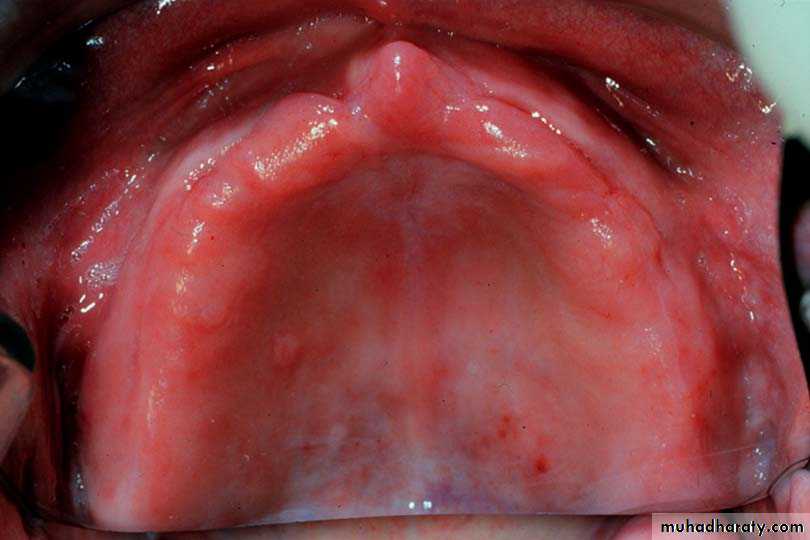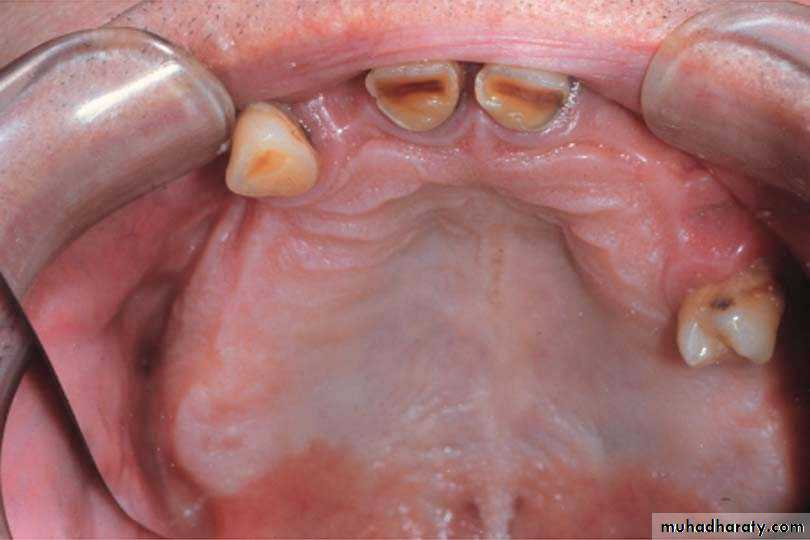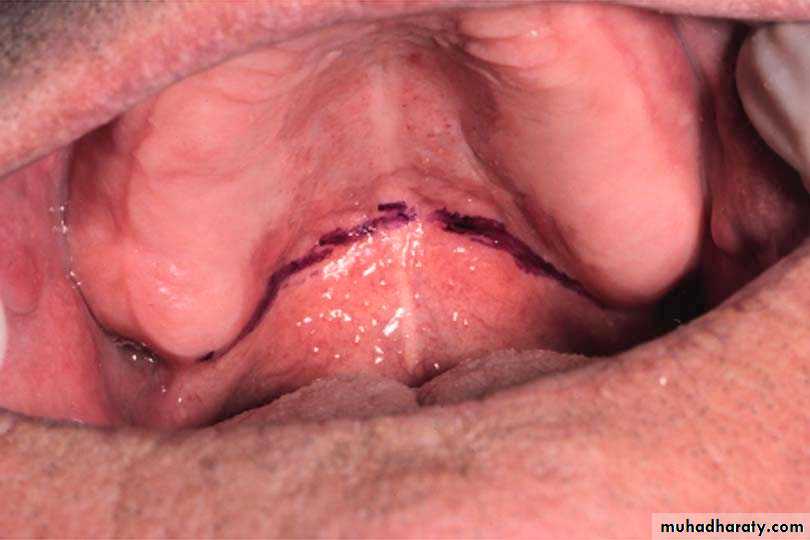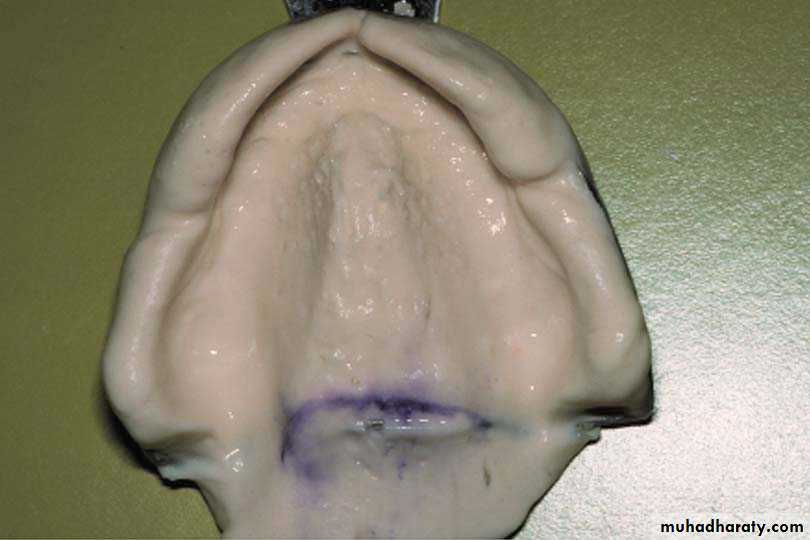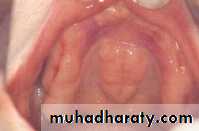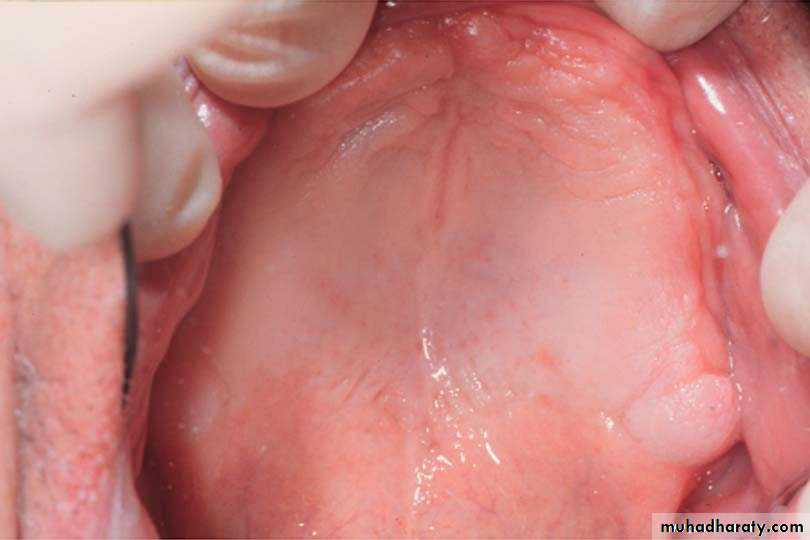Anatomical landmarks of the maxilla & maxillary arch
• Lecture TwoMaxillary anatomical land marks
Supporting structures• Mucous membrane
• Hard palate
• Rugae area
• Mid palatine raphae
• Residual ridge
• Incisive papillae
• Maxillary tuberosity
• Torus palatinus
Limiting and peripheral structures
• Labial frenum
• Labial vestibule
• Buccal frenum
• Buccal vestibule
• Hamular notch
• Vibrating line
• Fovea palatine
Maxilla & maxillary arch (supporting)..
Mucous membrane
A thin layer of tissue that lines a cavity, envelopes a vessel or part or separates a space or organ.
It consists of:
• Mucosa
• Submucosa
• Masticatory mucosa
• Lining mucosa
• Specialized mucosa
Maxilla & maxillary arch
PalateThe palate extends from the roof of the mouth all the way back to the uvula: divided into
Hard Palate. The hard palate is made up of the anterior two-thirds of the palatal vault supported by bone (palatine processes of the maxillae and the horizontal plates of the palatine bones).
Soft Palate. The soft palate is made up of the posterior one-third of the palatal vault that is not supported by bone. The soft palate is a muscular extension from the posterior edge of the hard palate, and it is very movable, especially during speaking and swallowing.
Maxilla & maxillary arch
¨ RugaeRugae are irregular ridges of fibrous tissue found in the anterior one-third of the hard palate.
It plays important role in speech.
Maxilla & maxillary arch
Median Palatine RapheThe medial palatine raphe is a slight tissue elevation which occurs in the midline of the hard palate, immediately over the median palatine suture.
Median Palatine Raphe (midline palatine suture)
A bony midline structureMay require relief when covered by a denture
Maxilla & maxillary arch
Alveolar ProcessThe alveolar process is a process of the maxilla that surrounds the roots of natural teeth. The right and left alveolar processes combine to form the maxillary arch.
Alveolar Ridge (Residual Ridge)
Defined as the portion of the residual bone and its soft tissue covering that remains after the removal of teeth.
The residual ridge is the remnant of the alveolar process which originally contained sockets for natural teeth. After natural teeth are extracted, the alveolar ridge can be expected to get smaller (resorb). The rate of resorption varies considerably from person to person.
Maxilla & maxillary arch
Maxillary Tuberosity
The maxillary tuberosity is the most distal (posterior) portion of the maxillary alveolar ridge.
Hamular Notch
The hamular notch is a deep depression located posterior to the maxillary tuberosity. The depths of this depression is part of a series of guides used to determine the posterior border of a maxillary denture.
Maxilla & maxillary arch
Incisive PapillaThe incisive foramen is located in the midline of the hard palate, immediately behind the central incisor teeth. The foramen is an exit hole for blood vessels and nerves. There is a definite bump or prominence in the oral mucosa which covers this hole in bone. The soft tissue bump immediately over the incisive foramen is called the incisive papilla. Since the incisive papilla is visible in the exact midline of the hard palate, just behind the natural central incisors, the papilla is a reliable guide for determining the midline relationships of upper anterior denture teeth.
Maxilla & maxillary arch
Vibrating LineThe vibrating line is the line of flexion between the hard and soft palates.
When a dentist looks at a patient’s entire palatal vault, it is easy to see an abrupt transition between the unmoving hard palate and the highly mobile soft palate. The line most frequently falls between the two hamular notches, on or near the palatine foveae in the midline.
Palatine Fovea
The palatine foveae are depressions made by two groupings of minor palatine salivary glands.
There are two palatine foveae. The two fovea are located on either side of the midline on, or very near the vibrating line.
Maxilla & maxillary arch (limiting)..
Labial FrenumThe labial frenum is a narrow fold of oral mucosa, which is found in the approximate midline. It extends from the inner surface of the lip to the labial surface of the alveolar ridge. The labial frenum is not a reliable guide for determining the midline of the face when natural teeth are absent.
Buccal Frenum
There are two buccal frena. These frena are located on each side of the arch, usually in the first bicuspid region. Each frenum extends from the mucosa of the cheek to the buccal aspect of the alveolar ridge.
Maxilla & maxillary arch
SulciThe maxillary sulcus is a groove formed by the mucosa of the cheek or lip and the mucosa at the base of the alveolar ridge. The portion of the sulcus which lies between the labial and buccal frena is called the labial sulcus, and the part of the sulcus between the buccal frenum and the hamular notch is the buccal sulcus. The muscles shaping the sulcus cause its depth to change with every facial expression a person makes.
Maxilla & maxillary arch
Torus palatinusIs defined as a smooth round anatomical protuberance.
It is a hard bony enlargement that occurs in the midline of hard palate and is found in 20% of the population.
Pterygo-Mandibular Raphe
Connects from the hamulus to the mylohyoid ridge,When prominent, can cause pain, or loosening,
Requires relief “groove ” if prominent.
Retrozygomal Fossae (Space)
Palpate zygomatic process in buccal vestibule just buccal to first maxillary molar
Vestibular space posterior to zygoma







